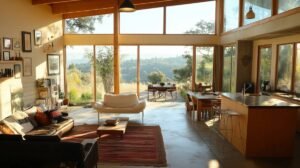Natural Ventilation Techniques
Using Breeze and the Stack Effect
Natural ventilation taps into the wind and stack effect, nicknamed the “chimney effect,” to cool homes without breaking a sweat with HVAC systems. This is a hit in dry climates and when the temperature plays nice, especially at night. But if you’re in a swampy climate, beware; this method can invite mold and mildew while messing up the air vibes indoors (Energy.gov).
Wind Effect: This is like giving your home a breath of fresh air. By arranging windows, vents, or louvers on opposite sides, wind sweeps in, creating a refreshing breeze through your space.
Stack Effect: This is the magic of warm air up, cool air down. Cooler air sneaks in low and rises as it heats up, exiting through strategic high-outlets. Building with a central atrium or limited cross-ventilation? This one’s your ally, but only if the indoor’s toastier than the outdoors (ArchDaily).
| Natural Ventilation | Wind Effect | Stack Effect |
|---|---|---|
| Mechanism | Uses outdoor air flow | Uses thermal lift |
| Ideal Conditions | Universal love everywhere | Tall buildings, average climates |
| Challenges | Wind can be a fickle friend | Needs that temp difference |
Designing for natural ventilation ought to consider where the building faces, where windows are put, and using fancy features like windows you can open, vents, and those nifty atriums. For design tips, check out HVAC ventilation design.
Boosting Home Design and Vegetation
Letting nature do the heavy lifting in keeping your home cool is savvy, especially in places that aren’t steamy. Know how to play with breeze and stacks and get the most out of your home’s design and greenery.
Home Design:
-
Building Orientation: Face your home right to catch the winds and get natural lighting. Putting windows right according to wind routes? Smart move.
-
Operable Windows and Vents: Having windows, vents, and louvers that you can open gives you power over how air flows, bringing in comfort while keeping things cool.
-
Atriums and Courtyards: Let these be your breeze boosters, promoting that uplifting stack to move air vertically through your place.
Vegetation:
-
Smart Planting: Growing trees and shrubs can break winds or lead airflow into your openings, playing nice with the wind factor.
-
Shading: Climbing plants on trellises offer natural shades, cutting the heat while improving airflow around the area.
-
Water Features: Ponds and fountains chill the air entering the home, making things comfier.
Leaning on natural ventilation can slash those energy bills and boost indoor air vibes. For those who wanna get fancy, check out our piece on whole house ventilation systems.
Homeowners and builders who embrace these design and landscaping tricks can cut down on mechanical ventilation systems. For even more scoop, dive into our article about the perks of good ventilation.
Types of Natural Ventilation
Got a stuffy room you want to air out? Natural ventilation could be your answer. It’s like giving your home a breath of fresh air. Let’s break down the three popular ways to let that air flow: single-sided, cross, and stack ventilation.
Single-sided Ventilation
Picture this: windows or vents on just one side of your pad, letting the breeze pop in and out. This is your single-sided ventilation. Perfect for small spaces or spots where you can’t fix windows on opposite sides (ArchDaily).
Handy for cozy rooms or spaces where the room’s length isn’t more than double the window’s height. Sure, it might not bring a chill like full-on cross ventilation, but hey, pair it with some mechanical backups, and you’re in business.
Cross Ventilation
Now, imagine openings on either opposing or neighboring walls. That’s cross ventilation for you. It’s like giving the air a highway in and out. Works a charm if you’re roasting away in a hot climate. Keeps things breezy and can even help cut down on energy bills (ArchDaily).
| Ventilation Type | What It’s Good For | Where to Use It |
|---|---|---|
| Single-sided Ventilation | Openings on one side | Small spaces, where space’s tight |
| Cross Ventilation | Openings on opposite or neighboring walls | Hot spots needing lotsa air |
Thinking of trying it at home? Peek at our guide on residential ventilation systems for more tips.
Stack Ventilation
Ever watched a hot air balloon rise? Stack ventilation uses that same trick—hot air going up. Fresh cooler air sneaks in down low, heats up, and away it goes to the sky. Works a treat in tall buildings with lots of vertical space (ArchDaily).
To get this air movement grooving, ensure that inside is warmer than out. Blend it with some snazzy HVAC ventilation plans for a seamless setup.
Using these tricks not only keeps things comfy, but can slash energy usage too, all while keeping the air indoors fresh as daisies. Whether you’re fixing up your place or planning builds, knowing how these work is super handy. For more on keeping the air just right, check out our article on the importance of good ventilation.
Considerations for Effective Ventilation
When setting up natural ventilation, you’ve gotta take a few things into account. These aspects are the secret sauce for making sure the system works well and keeps the air inside fresh and pleasant.
Climate and Geographical Factors
Natural ventilation takes advantage of things like wind and warm air rising to shuffle air in and out of buildings. But how well it works hinges a lot on the weather and where you are in the world.
-
Wind and Stack Effect: The stack effect, also known as the “chimney effect,” uses temperature differences between inside and outside to push air around. It’s a winner in dry places and when the weather’s mild, especially with cool evenings. But in sticky, humid places, it could lead to unwanted guests like mold and mildew.
-
Geographical Location: Natural forces like wind and rising heat can be used wisely if you’ve got the right building setup. We’re talking about how your building faces, where you put the windows, and those cool design features like movable windows, vents, and open spaces that help the air do its thing.
Building Design and Materials
How a building’s put together and what it’s made from make a big difference in getting the most out of natural airflow. With the right design, the air will flow like a dream and keep everyone comfy inside.
-
Building Orientation and Openings: Where you plop the building and how you design your windows and doors is huge. Think about which way the wind typically blows and those temperature swings. Moveable windows, vents, and open areas can really get the air moving.
-
Materials Used: What the building’s made of can also make or break ventilation. For example, choose stuff that doesn’t soak up a ton of heat during the day but lets it go at night—that really helps with natural airflow.
| Design Factor | Impact on Ventilation Efficiency |
|---|---|
| Building Orientation | Catches wind and rising heat |
| Window Placement | Boosts air movement and keeps things comfy |
| Architectural Features | Enhances air flow control and movement |
| Material Choice | Helps with heat balancing |
Smart natural ventilation setups can tackle issues with indoor air, cut energy costs, and serve as a green option instead of relying solely on those mechanical ventilation systems.
If you want to dive deeper into why having good air flow is awesome, go check out our detailed articles. They’ll give you the lowdown on why proper ventilation is something you don’t want to skimp on.
Benefits of Natural Ventilation
Energy Efficiency and Cost Savings
Who doesn’t love saving a buck? Natural ventilation is all about boosting energy efficiency at home without breaking the bank. Unlike those flashy mechanical systems, natural ventilation takes advantage of the wind and the good old chimney effect to cool off your living space. This method shines in dry or moderate climates.
Since there are no mechanical contraptions guzzling energy, your power bill takes a back seat. Designing a home to optimize natural airflow means less reliance on your HVAC system, and it shrinks your carbon footprint, too. Healthy air doesn’t need to cost the earth, after all! By using windows and vents wisely, you can pump up the airflow at practically no extra cost.
Check out how much you could save on energy:
| Method | Energy Savings |
|---|---|
| Natural Ventilation | Up to 30% on cooling costs |
| Mechanical Ventilation | 5-15% (even with energy-efficient models) |
For more on how mixing ventilation methods can save you even more, see our full scoop on whole house ventilation systems.
Improving Indoor Air Quality
Breathing easy is the ticket to a happier home! Natural ventilation is a champ when it comes to boosting indoor air quality. It refreshes your space by rolling in outdoor air and flushing out the stale stuff, tackling pollutants and allergens head-on.
Plus, ever worry about those sneaky mechanical systems? Poor maintenance can mean a buildup of nasties. Natural ventilation steps in by consistently inviting fresh air, keeping your environment clean with little fuss. That said, in muggy places, it might invite mold or mildew, playing a bit of a damp card on air quality.
Here’s a quick rundown on natural versus mechanical in the air quality game:
| IAQ Factor | Natural Ventilation | Mechanical Ventilation |
|---|---|---|
| Pollutant Levels | Lower (thanks to fresh air) | Moderate (maintenance-dependent) |
| Moisture Control | Tricky in humid areas | Better managed |
| Allergen Reduction | Higher (outdoor air power) | It varies |
Dive deeper into improving your home’s air with our indoor air quality guide.
Getting clued in on these benefits helps homeowners and number-crunchers make smart decisions about bringing natural ventilation aboard. By stirring up natural breezes in home design, you’re not just chasing atmosphere but catching cost-saving and health-boosting benefits too. Enjoy the comfort and fresh vibes while keeping those energy bills in check!


